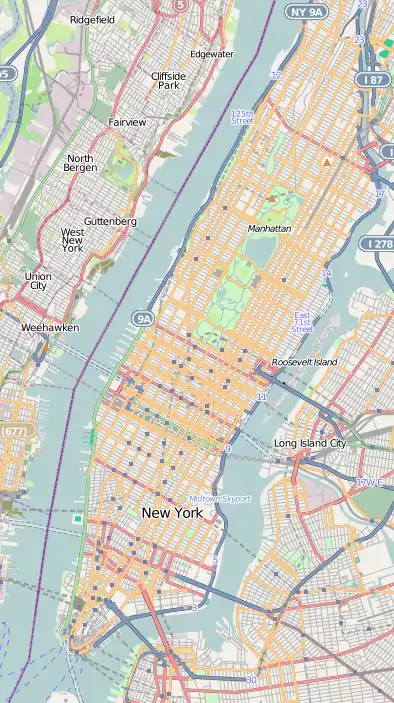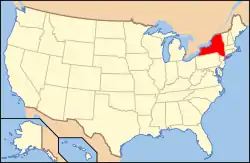Eldridge Street Synagogue
The Eldridge Street Synagogue is a synagogue and National Historic Landmark in Chinatown, Manhattan, New York City. Built in 1887, it is one of the first synagogues erected in the United States by Eastern European Jews.
Eldridge Street Synagogue | |
 (2006) | |
 Eldridge Street Synagogue  Eldridge Street Synagogue  Eldridge Street Synagogue | |
| Location | 12 Eldridge Street, Manhattan, New York City |
|---|---|
| Coordinates | 40°42′53.3586″N 73°59′37.899″W |
| Built | 1887 |
| Architect | Peter and Francis William Herter |
| Architectural style | Moorish Revival |
| NRHP reference No. | 80002687 |
| Significant dates | |
| Added to NRHP | March 28, 1980[1] |
| Designated NHL | June 19, 1996[2][3] |
| Designated NYCL | July 8, 1980 |
The Orthodox congregation that constructed the synagogue moved into the downstairs beth midrash in the 1950s, and the main sanctuary was unused until the 1980s, when it was restored to become the Museum at Eldridge Street.
History
.jpg.webp)
The Eldridge Street Synagogue is one of the first synagogues erected in the United States by Eastern European Jews (Ashkenazim).[4][5][6] One of the founders was Rabbi Eliahu the Blessed (Borok), formerly the Head Rabbi of St. Petersburg, Russia. It opened in 1887 at 12 Eldridge Street in New York's Lower East Side, serving Congregation Kahal Adath Jeshurun.[5] The building was designed by the architects Peter and Francis William Herter. The brothers subsequently received many commissions in the Lower East Side and incorporated elements from the synagogue, such as the stars of David, in their buildings, mainly tenements.[3] When completed, the synagogue was reviewed in the local press. Writers marveled at the imposing Moorish Revival building, with its 70-foot-high dome and barrel vaulted ceiling, magnificent stained-glass rose windows, elaborate brass fixtures and hand-stenciled walls.
As many as 800 families were members of the synagogue in its heyday, from its opening through 1920, and its sanctuary had a seating capacity of 1,000; [7] on High Holidays, police were stationed in the street to control the crowds.[7][8] Rabbis of the congregation included the famed Rabbi Abraham Aharon Yudelovich, author of many works of Torah scholarship. Throughout these decades the synagogue functioned not only as a house of worship but as an agency for acculturation, a place to welcome new Americans. Before the settlement houses were established and long afterward, poor people could come to be fed, secure a loan, learn about job and housing opportunities, and make arrangements to care for the sick and the dying. The synagogue was, in this sense, a mutual aid society.
For fifty years, the synagogue flourished. Then membership began to dwindle as members moved to other areas, immigration quotas limited the number of new arrivals, and the Great Depression affected the congregants' fortunes. The exquisite main sanctuary was used less and less from the 1930s on. By the 1950s, with the rain leaking in and inner stairs unsound, the congregants cordoned off the sanctuary.
Without the resources needed to heat and maintain the sanctuary, they chose to worship downstairs in the more intimate beth midrash (study hall). The main sanctuary remained empty for twenty-five years, from approximately 1955 to 1980. In 1986 the non-sectarian, not-for-profit Eldridge Street Project was founded to restore the synagogue and renew it with educational and cultural programs.[8] Paul P. E. Bookson, a former State Senator and Civil Court Justice, was instrumental in maintaining the Orthodox Religious services at the Eldridge Street Synagogue and its building restoration.[9] After his death in 2005, his widow, Mrs. Tova G. Bookson, continued to worship there.[8] At the beginning of the restoration work, in 1989, a skeleton was found in the basement of the synagogue.[10]
Renovation and reopening
On December 2, 2007, after 20 years of renovation work that cost US$20 million,[11] the Eldridge Street Project completed the restoration and opened to the public as the Museum at Eldridge Street, reflecting its cultural and educational mission, within the synagogue building. The museum offers informative tours that relate to American Jewish history, the history of the Lower East Side and immigration. Occasionally, Jewish religious events are celebrated there, though not in the former main sanctuary.[12]
The effort to return the sanctuary to its Victorian splendor, while maintaining the idiosyncrasies of the original aesthetic and preserving patina of age, included plaster consolidation and replication of ornamental plaster elements, over-paint removal, conservation, in-painting replication of stenciling, wood finishing and decorative painting including: faux-woodgraining, marbleizing, and gilding by skilled craftsmen.[13]
A small number of worshippers of the Orthodox Congregation Kahal Adath Jeshurun continue to hold services at the synagogue; the congregation has rarely missed a Sabbath or holiday service since the synagogue first opened.[14][15][16]
The synagogue was designated a National Historic Landmark in 1996.[2][3]
Gallery
 Stained glass with arch
Stained glass with arch Brass and glass lighting fixtures at pew ends
Brass and glass lighting fixtures at pew ends Front door with Moorish Revival detailing
Front door with Moorish Revival detailing Ceiling dome
Ceiling dome Arches and stained glass
Arches and stained glass Exterior Moorish Revival details
Exterior Moorish Revival details Interior staircase
Interior staircase
See also
References
Notes
- "National Register Information System". National Register of Historic Places. National Park Service. January 23, 2007.
- "Eldridge Street Synagogue". National Historic Landmark summary listing. National Park Service. September 11, 2007. Archived from the original on October 21, 2003.
- Newman, Renee; Schlanger, Maria; Waterman, Amy E. (June 1, 1995). "National Historic Landmark Nomination: Eldridge Street Synagogue" (PDF). National Park Service. Archived from the original (PDF) on November 4, 2012.
- New York City Landmarks Preservation Commission; Dolkart, Andrew S.; Postal, Matthew A. (2009). Postal, Matthew A. (ed.). Guide to New York City Landmarks (4th ed.). New York: John Wiley & Sons. p. 45. ISBN 978-0-470-28963-1.
- Dunlap, David W. (2004). From Abyssinian to Zion: A Guide to Manhattan's Houses of Worship. New York: Columbia University Press. pp. 60–61. ISBN 0-231-12543-7.
- White, Norval; Willensky, Elliot & Leadon, Fran (2010). AIA Guide to New York City (5th ed.). New York: Oxford University Press. p. 100. ISBN 978-0-19538-386-7.
- Bittner, David (August 12, 1993). "Our Great-Grandfather's Synagogue: Eldridge Street Synagogue – 107 years old – is looking for a rebirth." Jewish Journal (Deerfield Beach, Florida). p. 1B. Retrieved via Ethnic News Watch database, January 19, 2020.
- Santos, Fernanda (March 20, 2006). "Restoration of Synagogue Saves a Sense of History". New York Times. Retrieved February 25, 2020.
- "Paul Bookson, former judge, senator, synagogue leader". The Villager. October 4, 2005.
- "A Long-Lost Skeleton In a Synagogue Cellar". New York Times. April 14, 1989.
- Rothstein, Edward (December 1, 2007). "Return of a Long-Dormant Island of Grace". The New York Times. Retrieved July 31, 2010.
- Historic New York synagogue celebrates $20M restoration - Haaretz - Israel News
- Cole, Diane, "Joy on Eldridge Street", Preservation Magazine Volume 60, Number 2, March / April 2008, p. 56.
- "History". Museum at Eldridge Street. Retrieved January 19, 2020.
- Kuttler, Hillel (May 30, 2014). "Historic shul searching for old photos, families." J. The Jewish News of Northern California (San Francisco). p. 23, 30. "The [Eldridge Street Synagogue] does not have a full-time rabbi; a few dozen worshippers regularly attend Shabbat services." Retrieved via Ethnic News Watch database, January 19, 2020.
- Galatz, Karen (November 2018). "A Minyan on Eldridge Street". Hadassah Magazine. Retrieved January 19, 2020.
Bibliography
- Polland, Annie. Landmark of the Spirit; The Eldridge Street Synagogue,, Yale University Press, 2009
External links
| Wikimedia Commons has media related to Eldridge Street Synagogue. |
- Museum at Eldridge Street - official website

